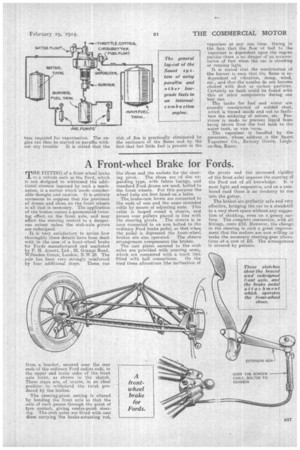A Front-wheel Brake for Fords.
Page 21

If you've noticed an error in this article please click here to report it so we can fix it.
THE FITTING of a front-wheel brake to a vehicle such as the Ford, which is not designed to withstand the additional stresses imposed by such a mech. anism, is a matter which needs considerable thought and caution. It is entirely erroneous to suppose that the provision ef drums and shoes on the front. wheels is all that is necessary. The application of the brakes causes a pronounced twist, ing effect on the front axle, and may affect the steering control to a dangerous extent unless the stub-axle pivots are redesigned.
It is very satisfactory to notice how thoroughly these details have been dealt with in the case of a front-wheel brake for Fords manufactured and marketed by F. H. Arnott, Ltd., 28, Grange Road, Willesden Green, London, N.W.10. The axle has been very strongly reinforced by four additional stays. These run
from a bracket, secured near the rear ends of the ordinary Ford radius rods, to the upper and lower sides of the front axle forks, as shown in the sketch. These stays are, of course, in an ideal position to withstand the twist produced by the brakes.
The steering-pivot setting is altered by bending the front axle so that the axis of each passes through the point of tyre contact, giving centre-point steering. The stub axles are fitted with cast discs carrying the brake-actuating rod, the shoes and the sockets for the steer
ing pivot. The shoes are of the expanding type, with fabric linings, and standard Ford drums are used, bolted to the front wheels. For this purpose the -wheel hubs are first faced on a lathe. .
-The brake-cam levers are connected to the ends of one and the same stranded cable by means of adjusting nuts. This cable is looped round a sheave, and passes over pulleys placed in line with
the steering pivots. The sheave is in turn connected to an arm bolted to the ordinary Ford brake pedal, so that when the pedal is depressed the front-wheel brakes are also operated. The sheave arrangement compensates the brakes. The cast plates secured to the .stub axles are provided with steering arms, which are connected with a track link fitted with ball connections. On the road these alterations (the inclination of the pivots and the increased rigidity of the front axle) improve the steering of
the Ford out of all knowledge. It is most light and responsive, and on a cambered road there is no tendency to run 'into the gutter.
The brakes are perfectly safe and very effective, bringing the car to a standstill in a very short space without any suggestion of skidding, even on a greasy surface. The complete conversion, with all fittings, costs £10. However, the change in the steering is such a great improvement that the makers are now willing to make the necessary steering-gear alterations at a east of £5. The arrangement is covered by patents.
































